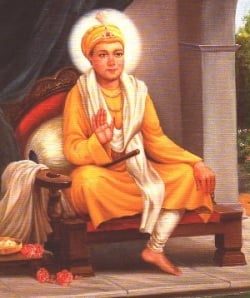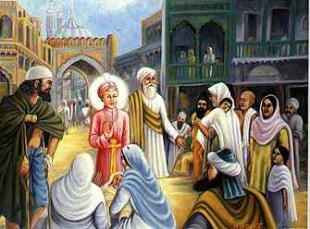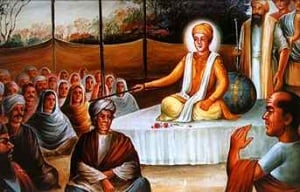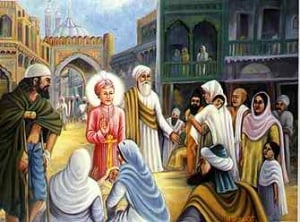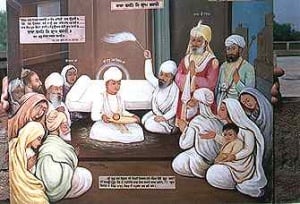Guru Har Krishan
| Guru Har Krishan (1656 to 1664) | |
| Full Name : | Har Krishan |
| Personal Details | |
| Birth : | Wednesday, 23 July 1656 |
| Guruship : | Sunday, 20 October 1661 |
| Joti Jot : | Saturday, 16 April 1664 |
| Family | |
| Parents : | Guru Har Rai & Mata Krishen Kaur |
| Brother/Sisters : | Brother - Baba Ram Rai |
| Spouse : | -N.A- |
| Children : | -N.A- |
| Other Details | |
| Bani in GGS: | N.A |
| Other Info: | Bangla Sahib construction, etc |
Sri Guru Har Krishan Sahib Ji (Gurmukhi: ਗੁਰੂ ਹਰਿ ਕ੍ਰਿਸ਼ਨ) (Wednesday, 23 July 1656 - Saturday, 16 April 1664) was the eighth of the Ten human form Gurus (divine messengers) of Sikhism. He was the second son of the seventh Guru, Sri Guru Har Rai Sahib Ji and Mata Krishan Kaur Ji (Sulakhni Ji). Before passing away in 1661, Guru Har Rai Sahib Ji had declared that his younger son Har Krishan, would be the next Sikh Guru. Thus, Har Krishan Sahib ascended to the throne of Guruship on Sunday, 20 October 1661, at the young age of five years.
In human history, there are but few devotees of God who have achieved a supreme level of spirituality in such a tender age, as Guru Har Krishan Sahib did. Despite his young age, Guru Sahib used to delight the hearts of his disciples by his commentaries on the passages from the holy scripture, the Guru Granth Sahib. He reminded people to cherish the One God alone, asking them to discard passions and learn the virtues of patience, charity and love.
During the year 1663, when Guru Har Krishan Sahib was in Delhi, a swear epidemic of cholera and smallpox broke out. The seven year old Guru attended to and served the suffering people with complete devotion. By his grace, the lake at Bangla Sahib provided a cure for thousands of peoples. In the process of serving the diseased, the Guru was himself seized by high fever and an attack of smallpox, eventually passing away on 30th March 1664, aged just eight years. The Guru wished that nobody mourn his death, rather instructing the Sikhs to sing hymns from the Gurbani. The Tenth Nanak, Guru Gobind Singh Sahib, later paid tribute to Guru Har Krishan Sahib by stating “Let us think of the holy Har Krishan, whose sight dispels all sorrow”, which forms a part of the daily Sikh prayer Ardas.
Before passing away, when Guru Har Krishan was questioned on his successor, he merely exclaimed "Baba Bakala ji", thus guiding Sikhs to the village Bakala near river Beas in the Punjab province, the location of the next Guru, Sri Guru Teg Bahadur Sahib Ji.
Detailed Account
Guru Har Krishan Sahib was born on Sawan Vadi 10, (8 Sawan), Bikrami Samvat 1713, (Wednesday, 23 July 1656) at Kiratpur Sahib. He was the second son of Guru Har Rai Sahib and Mata Krishan Kaur Ji (Sulakhni Ji). Ram Rai, the elder brother of Guru Harkrishan Sahib was ex-communicated and disinherited due to his anti-Guru Ghar activities, as stated earlier and Sri Harkrishan Sahib Ji at the age of about five years, was declared as Eighth Nanak Guru by his father Guru Har Rai Sahib before his death in 1661.
This act inflamed Ram Rai Ji with jealousy and he complained to Emperor Aurangzeb against his father's decision. The Emperor replied in favour issuing orders through Raja Jai Singh to the young Guru to appear before him. Raja Jai Singh sent his emissary to Kiratpur Sahib to bring the Guru to Delhi. At first the Guru was not willing to travel to Delhi, but after repeated requests of his followers and Raja Jai Singh, he agreed to the trip.
- The following quote from www.sikh-history.com
- Guru Har Rai passed away on 20 October 1661. Guru Har Krishan consoled the disciples. He asked them not to give way to despair but abide by the Will of the Almighty. All should sing God's praises and not weep or lament. As days went by, the disciples began pouring in from far and near. They were delighted to have a sight of the Guru. He sat on the throne, a small figure, young in years, but mature in wisdom.
Says Bhai Santokh Singh, "The early morning sun looks small in size, but its light is everywhere. So was Guru Har Krishan' s fame, without limit." Those who came to see him were instructed in true knowledge. They had their heart's desires fulfilled and their sins erased. The Sikhs recognized him as the picture of Guru Nanak. They saw on Guru Har Krishan's handsome face the same light as must have been on Guru Nanak's.
Guru Har Krishan had a rare ability in explaining passages from the Holy Granth. He delighted the hearts of his disciples by his commentaries. He reminded them to cherish the One God alone, and asked them to discard passions and learn the virtues of patience, charity and love. Thus Guru Har Krishan carried on the teaching of the Gurus and preserved intact the legacy he had inherited from them.
The Baisakhi day (March 29) of 1662 brought to Kiratpur vast numbers of followers. The festival lasted three days. The sangats were looked after by the Guru' s grandmother, Mata Bassi, and mother, Mata Sulakkhni. In the sangat of Sialkot district was Pair Mall of Pasrur, along with his family. His son, Khem Karan, was a promising youth. Mata Bassi betrothed her granddaughter, Bibi Rup Kaur, to him. Nuptials were held on December 3rd, 1662. According to the Guru kian Sakhian, the presents offered by Mata Bassi included a pothi of stories from Guru Har Rai' s mouth and a dagger belonging to Guru Hargobind.
Guru Ji To Delhi
Guru Ji and Mughal interference
Emperor Aurangzeb was not pleased to hear about the growing popularity of Guru Har Krishan. He asked the young Guru to visit his Darbar (Court) at Delhi as he done with his father, Guru Har Rai. His father, rather than going to Delhi himself at the beck and call of Aurangzeb, had sent his elder son, Ram Rai, to the emperor' s court.
Before his death Guru Har Rai, aware that Aurangzeb preferred Ram Rai as the next Guru of the Sikhs, cautioned his son to never meet with Aurangzeb. When a servant of Raja Jai Singh of Amber arrived with the emperor' s request, Guru Har Krishan took counsel with his leading Sikhs. With clasped hands, they replied "We are thy servants, Lord. With thy knowledge of 'the three worlds', thou knowest best." Guru Har Krishan, having made his decision, called for the messenger and told him that he would accompany him to Delhi. Travelling to Delhi, Guru Har Krishan traveled through Ropar, Banur and Ambala, often stopping to meet with crowds of his disciples who availed themselves of the chance to meet with their new Guru.
An Illiterate Recites Saloks
When Guru was near Panjokhara, a Sikh spoke with humility, "Sangats are coming from Peshawar, Kabul and Kashmir. Stay here a day so that they may have the chance of seeing you, Master." The Guru agreed. In that village lived a pandit, Lal Chand by name, who was proud of his caste as well as of his learning. He came to see the Guru and spoke with derision: "It is said that you sit on the gaddi of Guru Nanak. But what do you know of the old religious books'?" Hearing the pandit, Siri Guru Harkishan Sahib ji said, “If I successfully do the meanings of Geeta, you will raise the doubt by saying that since I am from a rich and resourceful family, I must have learned the meanings from scholars. This way you will stay faithless i.e. you will not get faith. Therefore, the first thing you should do is that go to your town and look for someone. Someone who is a Big fool, very ignorant person and call him to our Darbar right away. Whatever your questions are about Geeta, he will answer them for you. Hearing the nectarous bachans of Satguru ji, the pride in the pandit subsided a bit. He went to the town and looked for the most foolish, house to house.
Finally he found a person who he thought was ideal for the situation. The person was a deaf and dumb, totally uneducated and poor, called Chajju Ram.He was very big fool who could not speak. To earn his bread, he did meagre jobs. Clothes on him were torn. Let alone he getting any education, he had not even seen anyone study. This is how ignorant he was.
He was brought over to the Darbar of Siri Guru ji. The pandit was very happy thinking that the foolish person, Chajju Ram would never be able to speak, let alone do any translations of Geeta. Siri Guru ji right away caught the thought of the pandit and glanced at poor and uneducated Chajju Ram with “Shubh Disht” (Eye of grace) and with smile on his face, placed his chhadee (a stick) on his forehead(Chajju Ram's), all divine knowledge dwelled in the heart of the foolish man, Chhajju. The first thing that happened was that face of Chhajju Ram started reflecting the inner knowledge he had attained. His face started shining. He was then able to speak.
The pandit asked the most difficult salok from Geeta to be translated. Chhajju Ram, spontaneously gave the most exalted translation of the salok. Such was the translation that the pandit had never heard of such words before. He was wonderstruck. He could not believe his ears. He asked couple of more questions but then was too wonder-struck to say anything else. He was overtaken by immense humility. His hands folded. He moved forward and prostrated before Siri Guru Harkrishan ji. With extreme humility he pleaded: I have realized that your greatness is unmatched. You O Siri Guru Harkishan are Siri Krishna for me. Deliver me from this ocean of world. Have mercy on me. This way, Lal Chand's pride was overcome. Humbly he fell at the Guru's feet. Both men became the Guru's disciples and travelled with him up to Kurukshetra. Lal Chand, taking Pahul became Lal Singh and was one of the Sikhs who fought with Guru Gobind Singh in the battle of Chamkaur on December 7, 1705, where he fell as a Martyr.
Guru Ji in Delhi
When Guru Sahib reached Delhi, he was greeted with great fervor and full honors by Mirza Raja Jai Singh and the Sikhs of Delhi. Guru Sahib was lodged in the palace of Raja Jai Singh. The people from all walks of life flocked the palace to have a glimpse (Darshan) of Guru Harkrishan Sahib. Some chronicles mention that prince Muzzam also paid a visit.
In Delhi, Guru Har Krishan put up in Raja Jai Singh's bungalow which is now the site of Gurdwara Bangla Sahib. The house was a spacious one "designed to suit all the seasons of the year." The Sikhs of Delhi started coming in groups to see the Guru. They came chanting the holy songs and brought offerings with them. According to the Guru kian Sakhian, Guru Har Krishan visited the emperor's court on Chet Sudi Naumi, 1721 Bk/March 25, 1664.
As says the Mahima Prakash, the emperor had planned a trial. He had two large trays laid out for the Guru. One of these displayed ornaments, clothes and toys. The other had in it a holy man's cloak and cowl. Both were presented to Guru Har Krishan. He rejected the tray containing ornaments and clothes, and accepted the one containing the cloak. The emperor was convinced of his holiness. He thought he would invite him again and see him perform a miracle. Guru Har Krishan guessed what the emperor had in his mind. He told himself that he would not see his face again. He believed that no one should attempt a mirage and try to disturb the law of God. Guru Har Krishan knew how his father had punished Ram Rai, his elder brother, for showing feats in Aurangzeb's court.
Guru Ji and Rani
In order to test the Guru's intelligence, of which everyone spoke very highly, Raja Jai Singh requested the Guru Sahib to identify the real queen out of the equally and well dressed ladies surrounding Guru Sahib. The Guru at once went to a lady dressed as a maidservant and sat in her lap. This lady was the real queen. There are also many different stories we find in some other Sikh accounts relating to Guru Sahib's mental ability.
The Rani had devised her own test. she asked her husband, Jai Singh, to bring the Guru to the ladies' dwelling-house. The Guru accepted the invitation. At the entrance to the inner apartments of the palace, he was received by the Raja's servants with due honour. As he stepped inside, the ladies, in their costly jewels and clothes, bowed in reverencers He walked past them acknowledging their greetings. As he came near one dressed modestly in a maid's coarse homespun, he stopped and said, You are the Rani. Why should you have dressed yourself in a maid's suit?" The Rani bent her head in homage. Within a short span of time Guru Harkrishan Sahib through his fraternization with the common masses gained more and more adherents in the capital.
Guru Ji and Small Pox
At the time, a severe epidemic of cholera and smallpox was ravaging Delhi. The young Guru began to tend to the sufferers irrespective of their cast and creed. Particularly, the local Muslim population was so impressed with the purely humanitarian deeds of the Guru Sahib that they gave him the nickname of Bala Pir (child prophet). Even Aurangzeb did not try to disturb Guru Harkrishan Sahib sensing the tone of the situation but on the other hand he never dismissed the claim of Ram Rai.
While serving the suffering people from the epidemic day and night, Guru Sahib himself was seized with high fever. Suddenly one day Guru Har Krishan was taken ill with a fever. The fever turned out to be the beginning of an attack of smallpox, which confined him to bed for several days. The Guru's tender body was ravaged by the disease. Saddened by this turn of events, the Guru's mother, Mata Sulakkhani said:
- "Son, you occupy the gaddi of Guru Nanak, you are the dispeller of the world' s sorrows and sufferings, your very sight removes the ailments of others so why do you lie sick now?"
- Guru Har Krishan replied, "He who has taken this mortal frame must go through sickness and disease. Both happiness and suffering are part of life. What is ordained must happen. This is what Guru Nanak taught. Whatever He does is His order. One must walk in the light of His command."
Guru Har Krishan had himself taken out of Mirza Raja Jai Singh's house to a camp put up on the bank of the Jamuna. The Sikhs wondered why the Guru suffered thus. Why was this darkness surrounding the sun itself? They were in despair and wondered who would take the gaddi after him. Guru Har Krishan, as says the Sri Gur Pratap Suraj Granth, instructed them in this manner:
- "The Gurgaddi, Guru Nanak's throne, is eternal. It is everlasting and will command increasing honour. The Granth is the Lord of all. He who wants to see me, let him with faith and love see the Granth. So will he shed all his sins. He who would wish to speak with the Guru, let him read the Granth with devotion. He who practises its teachings will obtain all the four padarathas, (4 most cherished objects) of human life. He who has faith gains all. He who is without faith acquires but little. None in this world liveth forever. The body is mortal. In the Granth abides the Guru' s spirit. Daily bow your head to it. So will you conquer your passions and attain liberation."
Tears filled the Sikhs' eyes as they listened to what sounded like the last words of the Guru. Then mother Sulakkhani came forward. With tears in her eyes, she spoke, "How shall I live without thee, son? I was blessed when I came into this family married to the late Guru. I was blessed when you were born. Now I am cast into a bottomless ocean of sorrow. Who would be my rescuer? How does a fish live separated from water?" "The body is perishable," said Guru Har Krishan. "As you learn to have faith in God's Will, you will attain to realms sorrowless. Eternal peace will be yours."
Today Delhi's Gurdwara Bangla Sahib, was constructed by Sardar Baghel Singh, the Sikh General who took control of Delhi, around the Princely Haveli of Raja Jai Singh, where Guru Harkrishan ji had stayed during his time in Delhi.
Baba Bakala
Shortly before his death, realizing the gravity of the situation, Guru Har Krishan called his mother and told her that his end was drawing near. When asked to name his successor, he merely exclaimed 'Baba Bakala'. Learning of his pronouncement many would style themselves as the next Sikh Guru at the village of Bakala. However, at the time the future (Guru) Teg Bahadur Sahib, was residing at village Bakala near river Beas in Punjab province.
In the last moment Guru Harkrishan Sahib wished that nobody should mourn him after his death and instructed to sing the hyms of Gurbani. Thus the 'Bala Pir' passed away on Chet Sudi 14,(3rd Vaisakh), Bikrami Samvat 1721, (Saturday, 16 April 1664) slowly reciting the word "Waheguru" till the end. Tenth Nanak, Guru Gobind Singh Sahib paying tribute to Guru Harkrishan Sahib stated in "Var Sri Bhagoti Ji Ki"... "Let us think of the holy Harkrishan, Whose sight dispels all sorrows..."
Mother Sulakkhani's heart was awakened to the truth and she felt herself released from her worldly chains. Guru Har Krishan was in a critical state. Yet he did not fail to carry out his important responsibility before he left the mortal world. In his last moments, he was able to nominate his successor. He asked for the ceremonial marks of succession to be fetched. But all he could say was "Baba Bakale." He meant that the next Guru would be found in the town of Bakala. The reference was unmistakably to Tegh Bahadur.
The Guru's physical departure
Guru Har Krishan physical body passed away from this planet on Saturday, 16 April 1664. He was cremated at the present site of this Gurdwara, Bala Sahib Gurdwara. This was the place where he had camped to look after the sick and suffering poverty stricken people of Delhi. He was long remembered by the Muslims as "Bala Pir" and by the Hindus as "Balmukand". In their Invocation prayer (ardas) written by Guru Gobind Singh, the Sikhs repeat everyday these words,"Contemplate on Guru Harkrishan, the vision of whose divine personality dispels all sorrow and suffering."
According to the Guru kian Sakhian, Mata Bassi, the grandmother, asked Bhai Gurdas, of the family of Bhai Bahilo, to start a reading of the holy Granth in his memory. Dargah Mall and Munshi Kalyan Das were sent to Punjab with the mournful news. They first went to Kiratpur to inform Guru Har Krishan's sister, Bibi Rup Kaur. The next day, they set out for Bakala to inform Tegh Bahadur (the future Guru Tegh Bahadur) of his brother's death. While in Delhi, he had met with Guru Har Krishan and now he received the news of his passing away.
Diwan Dargah Mall and Munshi Kalyan Das stayed at Bakala for three days before returning to Delhi. According to an entry in the Bhatt Vahi Talauda Parganah Jind, the ashes were taken from Delhi to Kiratpur where they were mixed with the waters of the Sutlej. The original entry is translated below:
- "Sangat, son of Binna Uppal, of Amb Mari, parganah Miyen ka Maur, Nanu Ram, son of Bagha, calico-printer, of Mohalla Dilwali, Delhi, Jaggu, son of Padma, of Duburji, parganah Sodhara, and Dariya, son of Mula, of Alipur Shamali, parganah Multan, carried the ashes of Guru Har Krishan from Delhi and arrived at Kiratpur, parganah Kahlur, on the 11 th of the dark half of the month of Bhadon of 1721 Bk/ Saturday, 16 April 1664. The ashes were immersed in the River Sutlej. Karahprasad was distributed."
External links
- DiscoverSikhism - Sri Guru Harkrishan Ji Sri Guru Harkrishan Ji is eight of the Ten Sikh Gurus. Read about his life and stories here.
- www.sgpc.net
- Sikh Missionary Society
- www.allaboutsikhs.com
- www.sikhvideos.org
| Preceded by: Guru Har Rai (Seventh Sikh Guru) |
Guru Har Krishan | Followed by: Guru Teg Bahadur ("Hind -dee- chader" - The Protector of Hindus) |
| These are the Ten Gurus of Sikhism |
|
Guru Nanak | Guru Angad Dev | Guru Amar Das | Guru Ram Das | Guru Arjan | Guru Hargobind | Guru Har Rai | Guru Har Krishan | Guru Teg Bahadur | Guru Gobind Singh |
